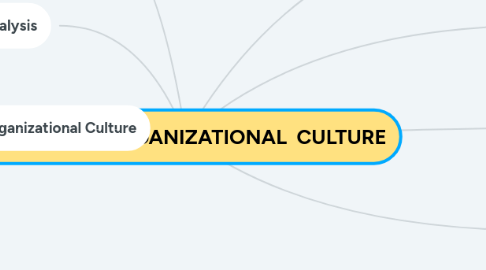
1. The Effects of Culture on Individuals
1.1. social norms
1.1.1. Peripheral norms
1.1.2. Relevant norms
1.1.3. Pivotal norms
1.2. shared values
1.2.1. cultural control mechanism
1.3. shared mental models
1.3.1. defines a causal relationship between two variables
2. Organizational Culture Analysis
2.1. Three levels of culture
2.1.1. Artifacts
2.1.1.1. Visible organizational structures and processes
2.1.2. Values
2.1.2.1. Stated strategies, goals, philosophies, and justifications
2.1.3. Assumptions
2.1.3.1. Basic underlying assumptions
2.1.3.2. Unconscious
2.1.3.3. Taken for granted beliefs
2.1.3.4. Perceptions, thought, and feelings
3. Strategic Implications of Organizational Culture
3.1. Clearly define desired cultural outcomes.
3.2. Assess the current cultural state.
3.3. Diagnose the existing culture with respect to desired knowledge-sharing behaviors.
3.4. Assess tolerance to change.
3.5. Identify change enablers and barriers.
3.6. Assess the maturity level of KM within the organization.
3.7. Identify KM enablers and barriers.
3.8. Conduct a gap analysis to yield a map on how to get from where the organization is currently to where it would like to be culturally.
4. Culture at the Foundation of KM
4.1. Communication systems
4.2. knowledge-sharing culture
4.2.1. characteristics
4.2.1.1. Reward structure舒?recognition for knowledge sharing with peers.
4.2.1.2. Openness/transparency舒?no hidden agendas.
4.2.1.3. Sharing supported舒?communication and coordination between groups.
4.2.1.4. Trust舒?shared objectives.
4.2.1.5. Top management support舒?upward and downward communication.
4.3. Collaborative Climate
4.4. Explicit Knowledge Sharing
5. Cultural Transformation to a Knowledge-Sharing Culture
5.1. Values
5.2. Norm
5.3. Assmption
5.4. Open Space Technology
5.4.1. Four principles
5.4.1.1. Whoever comes is the right person
5.4.1.2. Whatever happens is the only thing that could have happened.
5.4.1.3. When it starts is the right time
5.4.1.4. When it舗?s over it舗?s over.
5.4.2. Law of Two Feet
5.4.2.1. 舠?If you find yourself in a situation where you are not learning or contributing, go somewhere where you can.舡?
6. Organizational Maturity Models
6.1. Capability Maturity Model
6.1.1. Initial
6.1.2. Repeatable
6.1.3. Defined
6.1.4. Managed
6.1.5. Optimizing
6.2. STAGES OF ORGANIZATIONAL MATURITY
6.2.1. Chaotic
6.2.2. Ad hoc
6.2.3. Organized
6.2.4. Managed
6.2.5. Agile
6.3. KM Maturity Models
6.3.1. Default Stage
6.3.2. Reactive Stage
6.3.3. Aware Stage
6.3.4. Convinced Stage
6.3.5. Sharing Stage
6.4. CoP Maturity Models
6.4.1. Paulk organizational maturity
6.4.2. Fujitsu organizational maturity
6.4.3. Infosys KM
6.4.4. Paulzen and Perc KPQM
6.4.5. Forrester Group KM maturity Model
6.4.6. Wenger CoP life-cycle model
7. Different Types Of Cultures
7.1. Exploring Cultures
7.1.1. Goffee and Johns
7.1.1.1. Sociability
7.1.1.2. Solidarity,
7.1.2. Organizational culture
7.1.2.1. Communal Culture
7.1.2.2. Networked Culture
7.1.2.3. Mercenary Culture
7.1.2.4. Fragmented Culture

